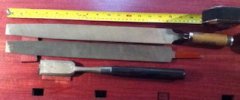A while back, I was fiddling with a Manix2 in S90V and, on a whim, picked up another knife nearby in VG-10 and lightly 'steeled' the S90V blade's edge on the flat-ground sides of the VG-10 blade. The VG-10's fine satin finish was left with ugly scratches all over it. As mentioned above, in the long term, the 'steel' or burnisher would likely be altered (scratched, polished, etc) by the vanadium carbides in high-wear steels, and maybe even chromium carbides, if a lot of them are there.
On high-hardness, high VC blades, I view 'steeling' as something that wouldn't likely be effective in the long run. Short-term, immediately after sharpening on stones, most any kind of steeling can work like basic stropping to break away fragments of burrs or other weakened metal at the edge, which can leave the edge cleaner & sharper at that immediate point. But following that, when I've tried to use a steel for subsequent touchups on high-wear steels, I've seldom seen much help from it after that initial improvement seen immediately after sharpening. Once the post-sharpening weakened fragments come off the apex, there's not much it can do to help, beyond that.
On the other hand, using a Fine/EF/EEF diamond hone in the same featherlight manner as a 'steel', on such blades, brings every bit of the sharpness back, and does it very quickly.
Steeling is at it's very best on relatively low-hardness (mid-high 50s HRC), ductlle blades that can roll easily at the edge, and therefore can be easily and repeatedly realigned by steeling. That ductility is also what makes 'burnishing' work on such knives, allowing the steel near the edge to be moved around and reshaped somewhat. But high-wear blades with lots of carbide content won't usually, if ever, be that ductile or as soft as a run-of-the-mill kitchen knife in simple stainless.




